|
Each great monastery in Tibet once possessed giant silk applique hangings for public display and worship. These often huge banners comprise some of Tibet's greatest art treasures because of their spiritual significance, size and intricate design. Some survived the cultural revolution - most did not. The giant banners of Tsurphu monastery in central Tibet - traditional seat of the Karmapas - were both destroyed during this time.
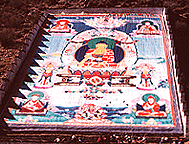 Between 1992-1994, the making of a 23x35 metre silk/brocade
applique banner of Sakyamuni was undertaken fusing Tibetan and Western expertise. The first ceremonial display of this image, in May 1994, marked the revival of an age old tradition that had not been observed at Tsurphu for 36 years.(fig 1, left)
Between 1992-1994, the making of a 23x35 metre silk/brocade
applique banner of Sakyamuni was undertaken fusing Tibetan and Western expertise. The first ceremonial display of this image, in May 1994, marked the revival of an age old tradition that had not been observed at Tsurphu for 36 years.(fig 1, left)
The same team of artists created a second large scale applique hanging-
9 x 9 metres-for the same monastery.
Completing both these works coincided with a major restoration and
rebuilding effort presently still underway at Tsurphu. A decade earlier
this important 300 square metre temple complex was still mainly rubble.
Tsurphu monastery dates back to 1187 when the first Karmapa - Dusum Kyenpa - identified the auspicious location for his dwelling. It is with this Karmapa that the tradition of reincarnating lamas was introduced throughout the various schools of Tibetan Buddhism.
Significantly, the present constructive energy at Tsurphu has
arisen with the arrival of the reincarnate 17th Karmapa- Urgyen Drodul Tinley Dorje- who was enthroned at Tsurphu September 1992.
Between 1997- 2007 a further project was being planned. Two ceremonial
appliqués, 2 x 40 Mts. (7’ x 120’) as companion pieces
for the two thangkas.
The 1st the Norbu Drachey was completed July 2007. Now the second,
the Tsecur Drachey is beginning. At the end of this article, an update
contains all the new information.
The First Giant Thangka for Tsurphu
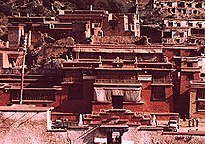 Tsurphu monastery is situated in a valley two hours
north-west of Lhasa (fig 2, right).. The landscape here, at over 4000m, is mainly sloping mountainsides brightly speckled with wild flowers in the warm season --white peaks ahead and rushing river below. On the south bank of the river, in front of the new monastery, are the old steeply inclined steps upon which the gigantic applique image is displayed for a few hours each year. Tsurphu monastery is situated in a valley two hours
north-west of Lhasa (fig 2, right).. The landscape here, at over 4000m, is mainly sloping mountainsides brightly speckled with wild flowers in the warm season --white peaks ahead and rushing river below. On the south bank of the river, in front of the new monastery, are the old steeply inclined steps upon which the gigantic applique image is displayed for a few hours each year.
The creation of such huge images is
traditional throughout Tibet. (fig 3, left, at Drepung) They are referred
to as "gos.sKu." (pronounced Ki-gu) in Tibetan, literally means "Satin-image".
These hangings are, in fact, constructed using a range of heavy brocades,
silks and satins sewn them together in the applique technique. The intricate
linework is translated using a technique similar to that found in Tibetan
tent design, typical of this culturally nomadic people. The
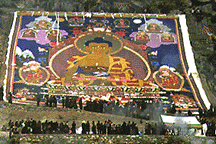 Karmapas, in particular, were renowned for their elaborate tent settlements.
In addition, styles in art and iconography differ according to the various
religious schools. The Karma Kagyu style, known as Karma Gadri, was
established in 1500 and reflects influence from India (in its form),
China (in its colouring) and Tibet (in its composition). Interestingly,
His Holiness has named this giant thangka The Karma Gadri Thangka.
Karmapas, in particular, were renowned for their elaborate tent settlements.
In addition, styles in art and iconography differ according to the various
religious schools. The Karma Kagyu style, known as Karma Gadri, was
established in 1500 and reflects influence from India (in its form),
China (in its colouring) and Tibet (in its composition). Interestingly,
His Holiness has named this giant thangka The Karma Gadri Thangka.
These aspects were very much considered when constructing the
new gos.sKu for Tsurphu monastery. This thangka, completed in the
spring of 1994, was made to replace the previous 17th century applique made during the time of the 10th Karmapa.
This thangka, completed in the spring of 1994, was made to replace the previous 17th century applique made during the time of the 10th Karmapa.
|
As there was no photographic record of this image, the artists were requested to re-design the work based on the oral instructions and guidance given by the present abbot of Tsurphu, the Venerable Drupon Dechen Rimpoche. Hence the new design is closely based on the previous banner, though two Lamas now represented, but not found in the original design, reflect its contemporary nature. Such updating is a traditional feature of making devotional lineage images in Tibet.
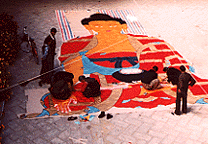 The work, 23x35 metre in size, features nine figures:
Sakyamuni Buddha in the centre (9m high) (fig 4, right); Manjusri and Maitreya Bodhisattvas flanking him (7m high); the Primordial Buddha at the top centre
(fig 5, below left) and a fierce wrathful protector at the bottom centre. At each corner of the image sits a great Lama of the lineage - The First and Second Karmapas are in the upper corners; the Sixteenth Karmapa, who passed away in 1981, and the Third Jamgon Kontrul, one of the Karmapa's foremost disciples who passed away in 1992, are featured in the lower corners. It is of significance that both these great Lamas focused much energy in propagating Dharma to the West; in consequence funding for this work was found among Eastern and Western disciples alike.
The work, 23x35 metre in size, features nine figures:
Sakyamuni Buddha in the centre (9m high) (fig 4, right); Manjusri and Maitreya Bodhisattvas flanking him (7m high); the Primordial Buddha at the top centre
(fig 5, below left) and a fierce wrathful protector at the bottom centre. At each corner of the image sits a great Lama of the lineage - The First and Second Karmapas are in the upper corners; the Sixteenth Karmapa, who passed away in 1981, and the Third Jamgon Kontrul, one of the Karmapa's foremost disciples who passed away in 1992, are featured in the lower corners. It is of significance that both these great Lamas focused much energy in propagating Dharma to the West; in consequence funding for this work was found among Eastern and Western disciples alike.
 Other than these main figures, each individual in gesture,
ornaments and flowing robes, this image is adorned with additional
elements giving it a particularly intricate quality for such a huge
design. Symbolic beings and animals support the Buddha's throne; clouds and rainbows illuminate the sky above; peacocks and
gazelles graze peacefully before the lamas below, particularly,
the endangered species of Tibet's wildlife are featured: yaks, asses,
white-lipped deer, antelopes and the bluehorned sheep all have a place
in the image for special protection. Tibetan cranes and various other
birds (10 cm) are also present, even if sometimes hidden in the
foliage.
Other than these main figures, each individual in gesture,
ornaments and flowing robes, this image is adorned with additional
elements giving it a particularly intricate quality for such a huge
design. Symbolic beings and animals support the Buddha's throne; clouds and rainbows illuminate the sky above; peacocks and
gazelles graze peacefully before the lamas below, particularly,
the endangered species of Tibet's wildlife are featured: yaks, asses,
white-lipped deer, antelopes and the bluehorned sheep all have a place
in the image for special protection. Tibetan cranes and various other
birds (10 cm) are also present, even if sometimes hidden in the
foliage.
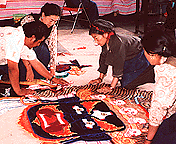 Over 1500 metres of silks and brocades were used to make the
Tsurphu gos.sKu (fig 6, right, the sewing team at work). Seventy shades of colour were chosen and a large
part of this palette was specifically dyed in Hong Kong to meet the
requirement of a Karma Gadri design which is noted for its use of
pastel shades. Additional materials for finishing the thangka
include: backing cloth (200m), a protective cover (1100m), a brocade
border (90m) and a 24 metre leather bag for storage. For ceremonial
purposes, a 24 metre canopy to be positioned above the gos.sKu was
made, banners, umbrella and 140 metres of multi-coloured traditional
streamers were all required and made for the unveiling event.
Over 1500 metres of silks and brocades were used to make the
Tsurphu gos.sKu (fig 6, right, the sewing team at work). Seventy shades of colour were chosen and a large
part of this palette was specifically dyed in Hong Kong to meet the
requirement of a Karma Gadri design which is noted for its use of
pastel shades. Additional materials for finishing the thangka
include: backing cloth (200m), a protective cover (1100m), a brocade
border (90m) and a 24 metre leather bag for storage. For ceremonial
purposes, a 24 metre canopy to be positioned above the gos.sKu was
made, banners, umbrella and 140 metres of multi-coloured traditional
streamers were all required and made for the unveiling event.
The Makers and Funds for the Tsurphu gos.sKu
 This project was initiated by the Tsurphu Foundation, a Western
based organization which has been involved with the re-building of Tsurphu monastery since 1985. Through the request and consultation of the Ven. Drupon Dechen Rimpoche (who was given the challenging responsibility of re building the destroyed Tsurphu monastery by the previous Karmapa) two Westerners trained in Tibetan art were encouraged to design and direct the making of the giant
thangka (fig. 7, left).
This project was initiated by the Tsurphu Foundation, a Western
based organization which has been involved with the re-building of Tsurphu monastery since 1985. Through the request and consultation of the Ven. Drupon Dechen Rimpoche (who was given the challenging responsibility of re building the destroyed Tsurphu monastery by the previous Karmapa) two Westerners trained in Tibetan art were encouraged to design and direct the making of the giant
thangka (fig. 7, left).
It was the first time a group from
the 70 odd workers there was
involved in the making
of a huge religious image.
|
Terris Temple (USA) has been involved in studying, creating and teaching Tibetan
thangka art for the last forty years. Prior to working on this project
he focused on teaching thangka iconography and painting to his student,
Leslie Nguyen (UK), former psychology graduate and art therapist, who
assisted him on the work. It was fortunate that both artists had together
earlier taken a growing interest in learning about applique thangkas,
particularly those made in the Amdo region, which are glued and folded
to create a traditional image using a combination of silks, brocades and
painted details.
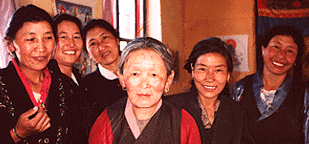 Creating a large scale image, however, demanded quite a different approach; notably that of an important workforce of sewers
to prepare and assemble large pieces of fabrics together. From
researching the various sewing techniques used mainly in the Lhasa
tent making factories, the artists found the perfect team of sewers who immediately accepted to participate in the work. The White Conch
factory, based in Lhasa, makes an array of Tibetan handicrafts ranging
from huge elaborate festival tents to traditional opera costumes and
temple hangings. It was the first time that a group from the 70
odd workers there was involved in the making of a huge religious
image. The six main sewers who spent eight months diligently
cutting and sewing silks together by both machine and hand, were all
women with over 20 years sewing experience in this setting (fig 8, right). Their efforts were co-ordinated by one Tibetan master tailor who, together with the artists, translated the giant drawing, meticulously measured and inked according to iconographical standards, into silken applique forms. It was all the more special and appropriate for this individual to be part of the making, as his father, some sixty years earlier, had also participated in sewing the gos.sKu for the Potala palace.
Creating a large scale image, however, demanded quite a different approach; notably that of an important workforce of sewers
to prepare and assemble large pieces of fabrics together. From
researching the various sewing techniques used mainly in the Lhasa
tent making factories, the artists found the perfect team of sewers who immediately accepted to participate in the work. The White Conch
factory, based in Lhasa, makes an array of Tibetan handicrafts ranging
from huge elaborate festival tents to traditional opera costumes and
temple hangings. It was the first time that a group from the 70
odd workers there was involved in the making of a huge religious
image. The six main sewers who spent eight months diligently
cutting and sewing silks together by both machine and hand, were all
women with over 20 years sewing experience in this setting (fig 8, right). Their efforts were co-ordinated by one Tibetan master tailor who, together with the artists, translated the giant drawing, meticulously measured and inked according to iconographical standards, into silken applique forms. It was all the more special and appropriate for this individual to be part of the making, as his father, some sixty years earlier, had also participated in sewing the gos.sKu for the Potala palace.
The benefit of this project is twofold: as well as replacing important lost religious images, it also offers an opportunity to train a skilled workforce in the making of these fine art pieces using traditional techniques. The continued supervision aims to fine-tune existing sewing skills to construct sacred images. The artists' guidance in use of colour, design and assembling work emphasizes the creation of a high quality finished work.
A younger workforce, until now not exposed to some of these intricate and specialized skills, is being trained in the hope of a long term use of these talents. As well as a revival of these methods, realizing such large scale and symbolically charged images clearly results in this Tibetan workforce gaining a new confidence and recognition within their community. For both the Tibetan and Western artists it was an immense
privilege to be involved in such work: The spirit of devotion,
fuelled by the continued blessings from H.H. Karmapa and all the monks at
Tsurphu, enabled the huge image to be conscientiously created in a
joyful atmosphere, free of obstacles. This, in itself, is somewhat
miraculous when one considers the scale of the project.
As well as designing and drawing the thangka and, identifying the
team of sewers in Lhasa, both westerners were responsible to acquire
best quality materials, and, more urgently, raise the funds required
to make the image. This they did by pledging to make a 2x3 metre replica
of the Tsurphu gos.sKu and offering it to the main patron of the giant
work. Subsequently, a German disciple of the late Jamgon Kontrul Rimpoche
presented her generous donation. Additional funds were needed to cover
costs of ceremonial items; these were offered from the Hong Kong Karma
Kagyu centre, the Malaysian Karma Kagyu centre (courtesy of the Tsurphu
Foundation) and a USA devotee from Hawaii. Furthermore, the "Yuo Hwa
Emporium" in Hong Kong greatly facilitated the purchasing and specific
dyeing of some of the satins needed.
The entire project took the artists a total of two years to complete,
from its inception in 1992. The last 4 months were spent making the
small scale replica of the thangka for presenting to the main patron
of this project. This replica has since been given to Pulahari Gompa,
Nepal.. Both worked together on this piece; sewers were not needed as
it was made using the glued, folded and painted techniques mentioned
above. This style has been continued by Leslie since that time.
The Giant Thangka Ceremony, Tsurphu Monastery
 The month of final assembling work began outside, in the
factory courtyard; but as the image quickly grew larger, a gymnasium in Lhasa became the
workspace (fig. 9, left). This allowed half of the thangka to be unrolled and viewed. Before the finished image was delivered to the monastery, certain preparations were made for it to be faithfully consecrated. The sacred syllables "OM", "AH", "HUNG" were cut out in fabric and sewn behind each figure, traditionally placed at their body, speech and mind centres. Also, a fragment of the 400-year old previous Tsurphu gos.sKu, a Bodhisattva head, was placed behind the Buddha's heart as a relic.
The month of final assembling work began outside, in the
factory courtyard; but as the image quickly grew larger, a gymnasium in Lhasa became the
workspace (fig. 9, left). This allowed half of the thangka to be unrolled and viewed. Before the finished image was delivered to the monastery, certain preparations were made for it to be faithfully consecrated. The sacred syllables "OM", "AH", "HUNG" were cut out in fabric and sewn behind each figure, traditionally placed at their body, speech and mind centres. Also, a fragment of the 400-year old previous Tsurphu gos.sKu, a Bodhisattva head, was placed behind the Buddha's heart as a relic.
The finished work was brought to Tsurphu and was consecrated
that same day by H.H. Karmapa, as it was displayed on the original wall
as a rehearsal for the coming event.
This physically demanding preliminary
requires the effort of at least 70 monks.
|
The ceremonial hanging of the Tsurphu gos.sKu takes place each
year on the 12th day of the Tibetan 4th lunar month. This date is the
important religious event of "Saga Dawa" which marks the Buddha's birth and enlightenment.
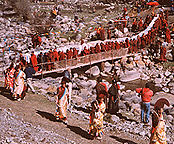 In the early morning, the huge thangka is carried from inside the main temple, where it is kept, through the monastery courtyard, across the river and up the facing hill to the top of the steep inclined wall on which it is
unfurled (fig. 10, right). This physically demanding preliminary requires the effort of at least 70 monks. The image is then unrolled and once its protective veil is raised, is visible for about 4 hours. During this time formal ritual offerings are performed and prayers are recited by monks below. This is followed by streams of pilgrims of all generations, presenting themselves before the giant thangka to make their devotional offerings (through the giving of silken scarves and making prostrations) whilst receiving its great blessing. From his balcony at the temple, the Karmapa witnesses the ceremony and crowded scenes below. Before the image is carefully rolled up and carried away for another year, the lines of pilgrims move away from it, across the landscape, towards the temple courtyard, where they wait to pay their respects and make offerings to H.H. Karmapa and receive his blessings.
In the early morning, the huge thangka is carried from inside the main temple, where it is kept, through the monastery courtyard, across the river and up the facing hill to the top of the steep inclined wall on which it is
unfurled (fig. 10, right). This physically demanding preliminary requires the effort of at least 70 monks. The image is then unrolled and once its protective veil is raised, is visible for about 4 hours. During this time formal ritual offerings are performed and prayers are recited by monks below. This is followed by streams of pilgrims of all generations, presenting themselves before the giant thangka to make their devotional offerings (through the giving of silken scarves and making prostrations) whilst receiving its great blessing. From his balcony at the temple, the Karmapa witnesses the ceremony and crowded scenes below. Before the image is carefully rolled up and carried away for another year, the lines of pilgrims move away from it, across the landscape, towards the temple courtyard, where they wait to pay their respects and make offerings to H.H. Karmapa and receive his blessings.
Update: Oct. 5, 1999:
The Next Giant Thangka for Tsurphu Monastery: The Mahakal Thangka
 In May, 1994, with the successful completion of this first large scale thangka, the abbot Ven. Drupon Dechen Rimpoche requested the artists to focus on making the second lost Tsurphu gos.sKu. This is to replace a 9 metre square applique thangka offered by the Mongolian king to the 15th Karmapa.
This image is shown on the last day of the Tibetan lunar calendar as part of a major purification ceremony to dispel impending obstacles before starting the new
year. In May, 1994, with the successful completion of this first large scale thangka, the abbot Ven. Drupon Dechen Rimpoche requested the artists to focus on making the second lost Tsurphu gos.sKu. This is to replace a 9 metre square applique thangka offered by the Mongolian king to the 15th Karmapa.
This image is shown on the last day of the Tibetan lunar calendar as part of a major purification ceremony to dispel impending obstacles before starting the new
year.
Again for this image, no photographic record exists making the creation of an exact reproduction impossible. However what was clearly known is that the thangka represents the protector Mahakala with his consort surrounded by his retinue of five wrathful attendants. It is shown at the festival which takes place on the last day of the Tibetan lunar calendar. The religious hanging is unfurled from the main temple's top balcony covering the front of the building. Meanwhile, ritual Lama dances are performed in the courtyard before the thangka; this is accompanied by the chanting of prayers. The festival traditionally attracts crowds of pilgrims who attend this major purification ceremony before beginning the new year afresh and, it is hoped, cleansed of any impending obstacles. impossible. However what was clearly known is that the thangka represents the protector Mahakala with his consort surrounded by his retinue of five wrathful attendants. It is shown at the festival which takes place on the last day of the Tibetan lunar calendar. The religious hanging is unfurled from the main temple's top balcony covering the front of the building. Meanwhile, ritual Lama dances are performed in the courtyard before the thangka; this is accompanied by the chanting of prayers. The festival traditionally attracts crowds of pilgrims who attend this major purification ceremony before beginning the new year afresh and, it is hoped, cleansed of any impending obstacles.
The central figures are those of Gonpo Bernagchen in union with his consort Palden Lhamo, both riding on her mule. To their right and left respectively, sits the great snake-tailed Naga King "Nadag" and the wealth guardian "Namthose". Below these, on the lower left side, the lion faced protectors "Shing Kyong" ride their horses through a smoke filled background. On the lower right
side, the skull garland black ogress "Sin Gon" stands in an aura of wild flames. At the bottom centre, the grandfather of all Mahakalas, "Damchen", the Blacksmith vow holder, rides seated on a goat.
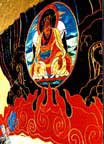 Overlooking these ferocious protectors, at the top centre of the image, sits the imposing frowning figure of the 2nd Karmapa, Karma Pakshi. Traditionally, in
painting, such wrathful compositions would be represented against a black background with landscape elements highlighted in lines of real gold. Similarly, this thangka is translated as a black applique thangka whereby the colourful wrathful deities are stitched against a black satin background. They are
surrounded by a landscape of golden silk linework depicting mountains against clouds and rainbows all amidst detail of flora, fauna and symbolic offerings. Overlooking these ferocious protectors, at the top centre of the image, sits the imposing frowning figure of the 2nd Karmapa, Karma Pakshi. Traditionally, in
painting, such wrathful compositions would be represented against a black background with landscape elements highlighted in lines of real gold. Similarly, this thangka is translated as a black applique thangka whereby the colourful wrathful deities are stitched against a black satin background. They are
surrounded by a landscape of golden silk linework depicting mountains against clouds and rainbows all amidst detail of flora, fauna and symbolic offerings.
Though this work is clearly smaller in scale than the previous gos.sKu created, its function is no less powerful: The act of representing these wrathful deities may result in a possible arising of subsequent obstacles: this was a forewarning given by the abbot to the artists, shielding them against any over-confidence resulting from their successful completion of the much larger image. Furthermore, on a technical level, smaller does not necessarily mean easier as this ensemble of ferocious deities are much more intricate in form, features and attributes than their peaceful counterparts. powerful: The act of representing these wrathful deities may result in a possible arising of subsequent obstacles: this was a forewarning given by the abbot to the artists, shielding them against any over-confidence resulting from their successful completion of the much larger image. Furthermore, on a technical level, smaller does not necessarily mean easier as this ensemble of ferocious deities are much more intricate in form, features and attributes than their peaceful counterparts.
The "Giant Tsurphu Thangka" video was used in a fundraising campaign in Hong Kong, Malaysia
and Taiwan which successfully raised half the money needed. At this time, Leslie and Terris celebrated the birth of their son, Karma Sonam
Dorje.
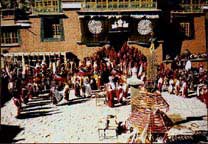 This thangka was completed and consecrated by H.H. the 17th Karmapa. The first public showing took place February 4, 1997, at twilight, as opposed to the
morning showing of the Buddha image. H. H. Karmapa greeted his protector image with an extremely rare performance of Mahakala dancing. After hours of masked rituals and lama dancing, the image was unfurled across the front of the monastery at
dusk This thangka was completed and consecrated by H.H. the 17th Karmapa. The first public showing took place February 4, 1997, at twilight, as opposed to the
morning showing of the Buddha image. H. H. Karmapa greeted his protector image with an extremely rare performance of Mahakala dancing. After hours of masked rituals and lama dancing, the image was unfurled across the front of the monastery at
dusk
The showings of both thangkas are accompanied by elaborate cultural events. The Buddha image is followed by the dance of Guru Rinpoche and his eight manifestations and attendants. The Mahakala
Protector image is associated with eighty masked and brocade robed dancers filling the monastery's courtyard. Both events are attended by thousands of colorful nomads and pilgrims in lively encampments.
This is the first time Westerners have participated in such a Tibetan project. For a male/female team of artists to find expression within the Tibetan tradition is
unique of artists to find expression within the Tibetan tradition is
unique
The Tsurphu Drawa Drachey Project
Two ceremonial banners
In addition to the two large thangkas they have already created, Terris
and
Leslie Nguyen Temple, presently the artists to H.H. the 17th Gyalwa
Karmapa , have been requested to undertake the making of the two ceremonial
silk applique banners for display in the main assembly hall at Tsurphu.
These two hangings, one peaceful (Tsechur Drachey ) and one wrathful,
( Norbu Drachey ), each measuring 7'x 120' ( 2 x 40 m. ), will be used
during important rituals and will complete Tsurphu's precious applique
relics lost during the cultural revolution. As with the past projects,
the responsibilities range from drawing work, acquiring materials, supervising
and sewing work in Lhasa as well as initial fund raising. This project
is being done in 2 phases.
Phase one ( Norbu Drachey ) was completed July 2007. The original Norbu
Drachey was a 120 foot long embroidery, we made it a silk appliqué
as nowadays a large embroidery would be difficult, as well as expensive.
Photos and information is available online at www.tibetcolor.com/tafuture.htm.
An estimated total cost of US $35,000 is required to complete Phase
2 of this project with a prospective minimum 18 month time period. This
project involves the same team of workers who completed the past applique
images for Tsurphu monastery. Donations can be given online or by contacting
the artists.
In 1992, Terris and Leslie created a small replica of the 1 st Giant
Thangka as part of the fund raising effort needed. This project was
completed in 1994.
In 1994, Terris and Leslie created and distributed to various dharma
centers a video presenting the making and displaying of the first thangka
now known as the Karma Gadri Thangka. This was instrumental in raising
funds for the 2nd giant project,the Mahakala thangka completed in 1997.
The "Giant Tsurphu Thangka" video.
The artists are presently seeking funding for completing the editing
of feature documentary with the express purpose of making this wonderful
project available to a wider audience. The editing is in the final stages.
The film will include:
A brief background of Tsurphu Monastery and the Karmapas.
The Tibetan tradition of giant appliqué thangka displays, at
the Sagadawa festival.
The process of building this sacred Tibetan Buddhist image from design
to final assembly and display.
The team of Western artists and Tibetan craftspersons in action.
rare footage of H.H. the 17th Karmapa at a young age
Updated interviews, with His Holiness, the artists, the tailors, Lamas
and others involved.
Guru Rinpoche Lama Dances during the Sagadawa Festival.
The original showing and the current annual event.
The completion of the rebuilding of the Monastery which was destroyed
in the mid 1960s.
Rare footage of the late Drupon Dechen Rinpoche, and other Tsurphu
Lamas
explaining the importance of this thangka.
If you are interested in supporting the making of this documentary
or have any other interest or information, please send an email to:
templeart@tibetcolor.com
Project Timeline
May 1994 the Karma Gadri Thangka was completed.
Jan. 1997 The Mahakala Thangka was completed.
July 2007 Phase 1 ( Norbu Drachey ) of the The Tsurphu Drawa Drachey
Project was completed.
Aug. 2007 Phase 1 ( Tsechur Drachey ) of the The Tsurphu Drawa Drachey
Project has begun.
2007 cont.
Terris and Leslie continue working on projects for Tsurphu.
These include design as well as fundraising.
Terris is completing the editing of the Tsurphu documentary, and painting.
He is also collaborating with a close friend and Tibetan scholar on
a book about Buddhism.
Leslie has been creating thangkas since 1994 based on the Amdo technique
of glued and painted appliqué.
Her works have evolved this style to a level of fine art and quality
and are being commissioned by Lamas, Dharma Centers, individual practitioners
and art collectors.
A few examples below.
This will be an interesting and busy year ahead.
We thank you for your attention and support.
For further information and contribution please contact: Terris and Leslie Nguyen Temple PO Box 747, Haiku. HI 96708
or
For further information, please click here to visit our website at
www.tibetcolor.com
Text and images © Terris
Temple, Leslie Nguyen and Asianart.com: not to be reproduced without
permission
Asianart.com |
Articles
Donations for Thangka Projects | Artists'
website
|






































